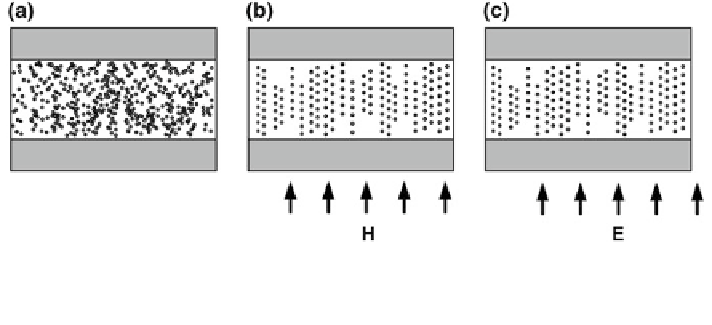Environmental Engineering Reference
In-Depth Information
Fig. 6.27 a The magnetorheologic or electrorheologic fluid in the absence of electric and
magnetic
elds, b The magnetorheologic fluid in the presence of an applied magnetic
eld, c The
electrorheologic fluid in the presence of applied electric
eld
volume fraction of the solid particles, the particle shape and size, the ratio of the
density of the two phases and the viscosity of the carrier
fl
uid. In most cases, the
shear stress also depends on the yield stress, which de
nes the conditions under
which the
fl
uid will start to
fl
ow. However, with the magnetic
eld being present,
the yield stress will drastically increase with the magnetic
eld strength, trans-
forming the liquid magnetorheologic
uid into a solid structure [
129
]. This trans-
formation can occur in a time period of milliseconds [
130
,
131
].
The magnetic particles can also be coated to prevent or reduce the effect of
sedimentation. Fang et al. [
132
] made analyses on two different MR suspensions,
among which the
fl
rst MR comprised carbonyl iron particles, and in the second, the
carbonyl iron particles were coated with multiwall carbon nanotubes (MWCNT) in
order to decrease the sedimentation effect. The addition of nanoparticles to the MR
can substantially in
fl
uence the magnetorheology and other properties of MR
fl
uids.
136
] exhibit similar behaviour to MRs. These
suspensions consist of a non-aqueous carrier
Electrorheologic (ER)
fl
uids [
133
-
fl
uid with suspended micron-sized
dielectric particles. As with the MR
fl
uids, the ER
fl
uids react strongly with the
applied electric
eld, which leads to a substantial increase in the apparent viscosity,
yield stress and shear stress up to several orders of magnitude and the transition
from a liquid to a solid-like substance [
134
,
135
]. Also in this case, a chain-like
structure of particles is formed in the direction of the electric
eld (Fig.
6.27
). The
application
uids is similar as that for magnetorheologics
[
133
]. There are also international conferences on Electrorheological Fluids and
Magnetorheological Suspensions, which deal with this important domain [
137
].
Since the aim of this subsection is to present the available technologies for
thermal diodes, magnetorheology and electrorheology can be potentially applied for
the following principles of thermal diodes:
eld of electrorheologic
fl
MR or ER thermal diode that applies a magnetically induced
fl
uid
fl
ow,
MR or ER thermal diode that acts as a thermal contact switch and
MR or ER thermal diode that applies the anisotropy of thermal conductivity.

Search WWH ::

Custom Search